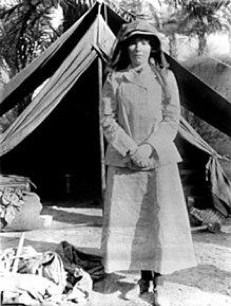Despite her important contribution, Gertrude Bell was ignored due to the acclaimed and mythologised presence of T. E. Lawrence, with whom she shared time and space, as well as mutual recognition. She shared with Egeria, Lady Montagu, Mary Kingsley, and subsequently with Freya Stark y Amelia Earhart her interest and her passion for travelling.

Gertrude Margaret Lowthian Bell
(Gertrude Bell)
Durham, United Kingdom, 14-07-1868 — Baghdad, Mandatory Iraq, 12-07-1926
Període d'activitat: 1892 — 1926
Classificació geogràfica: Àsia > Iraq Europa > Regne Unit
Moviments socio-culturals
Fites històriques > Primera Guerra Mundial
Fites històriques > Entreguerres
Grups per àmbit de dedicació
Governants > Polítiques
Viatgeres / Expedicionàries > Viatgeres
Humanístiques > Arqueòlogues
Escriptores
Artistes plàstiques, visuals i escèniques > Fotògrafes
Context de creació femenina
Ressenya
An archaeologist, traveller, diplomat and photographer, she studied Modern History at Oxford. She was fluent in eight languages, including Arabic. As a political administrator, she was responsible for the creation of the borders of the countries of the Middle East after World War I, and especially for the founding of the modern state of Iraq. Although Bell made important contributions to archaeology and to a greater understanding of the cultures of Mesopotamia and ancient Persia through her books, including what is still considered to be the best translation of the work of the Persian poet Hafiz, she is best remembered for her role in the partition of the Middle East.
Activitats
Justificacions
Biografia
Gertrude Bell was born in a very influential family; she was the granddaughter of Isaac Lowthian Bell, an important industrialist. She started her studies at Queen's College. When she was sixteen, she entered the Lady Margaret Hall College at Oxford University, where she got a degree in Modern History in just two years.
From 1892 on, after her first trip to Persia, which she described in her book Persian Pictures, Gertrude Bell greatly increased her trips to Orient, Palestine, Syria and Arabia (which she crossed six times) and published her second book: Syria, the Desert and the Sown. From 1907, she took part in campaigns of archaeological research of different sites along the Euphrates river. She was the first field controller of St John Philby and taught him the finer arts of spying.
After World War I, she wrote a report on the administration of Mesopotamia from the end of the war until the Iraqi revolt of 1920; afterwards, she contributed to delimit the boundaries in the post-war period. In 1921, she cooperated to make Faysal ibn Husayn, a son of the sharif of Mecca, ascend to the Iraqi throne. She also contributed to create the Iraq Museum and promoted her conviction that antiquities from excavations should remain in their country of origin. She also helped establish the National Museum of Iraq and promoted his conviction that antiquities from excavations should remain in their country of origin.
It is generally recognised that Gertrude Bell and T. E. Lawrence (Lawrence of Arabia) were the main instigators of the establishment of the House of Hashim in Jordan and Iraq. She promoted the Arab revolt during World War I. At the end of the war, she devised the boundaries of Mesopotamia.
Wikipedia, 10/03/2022, https://es.wikipedia.org/wiki/Gertrude_Bell
Obres
Persian Pictures (1894).
Poems from the divan of Hafiz, translated by Gertrude Bell (1897).
Syria, the Desert and the Sown (1907).
Amurath to Amurath (1911).
Letters (1927).
Bibliografia
Geniesse, Jane Fletcher (2001). Passionate Nomad: The Life of Freya Stark. Modern Library.
Howell, Georgina (2015). Gertrude Bell: A Woman in Arabia - The Writings of the Queen of the Desert. New York: Penguin Classics.
Howell, Georgina (2008). Gertrude Bell: Queen of the Desert, Shaper of Nations. Sarah Crichton Books.
Kriwaczek, Paul (2012). Babylon: Mesopotamia and the Birth of Civilization. St. Martin's Griffin.
Buchan, James (2003). “Miss Bell's Lines in the Sand” in The Guardian.
Said, Edward Wadie (1990). Orientalism. Vintage Books.
Hitchens, Christopher (2007). “The Woman Who Made Iraq” in The Atlantic.
Wallach, Janet (2005). Desert Queen: The Extraordinary Life of Gertrude Bell. Anchor Books.
Wikipedia, 19/03/2022, https://en.wikipedia.org/wiki/Gertrude_Bell
Morató, Cristina (2001). Viajeras intrépidas y aventureras. Barcelona: Plaza y Janés.
Marchena, Domingo (2020). “La mujer que pudo ser Lawrence de Arabia”. La Vanguardia, 19/03/2022, https://www.lavanguardia.com/ocio/viajes/20201218/6112247/gertrude-bell-lawrence-arabia-exploradora-espia.html
Documentary. La reina del desierto (2015). Germany. Werner Herzog
Enfocament Didàctic
In 3rd of ESO, Geography, in the block on the human space and in the topic of the political organisation of societies.
In History of 4th of ESO, the World War I. In Language and Literature too.